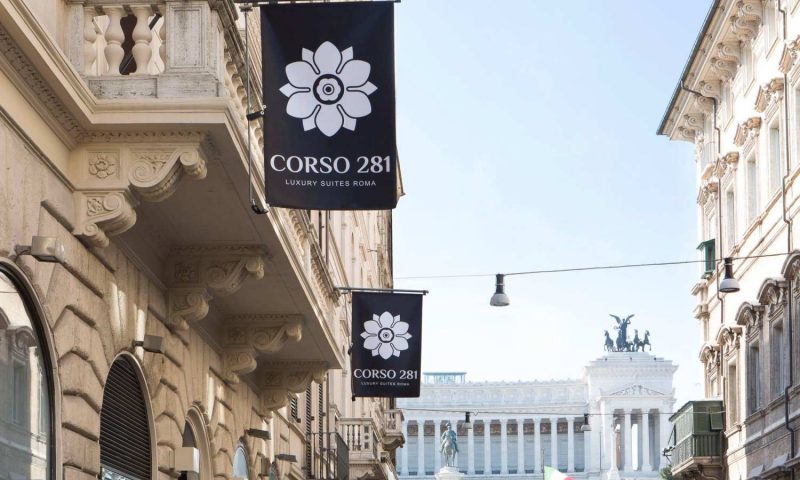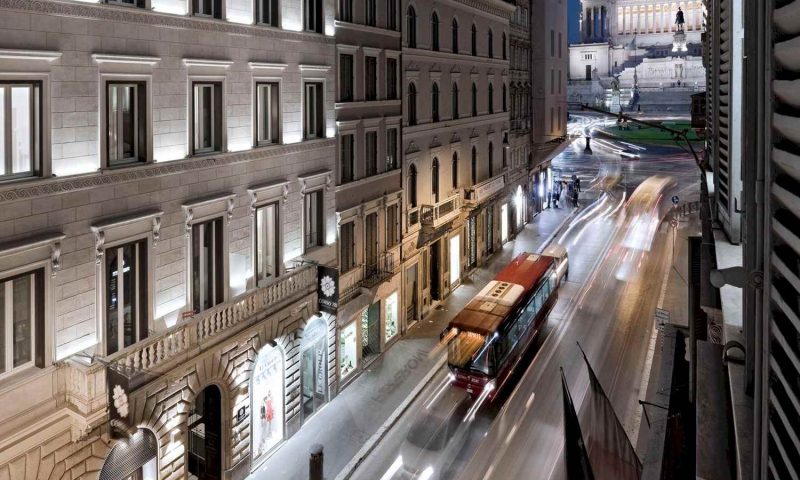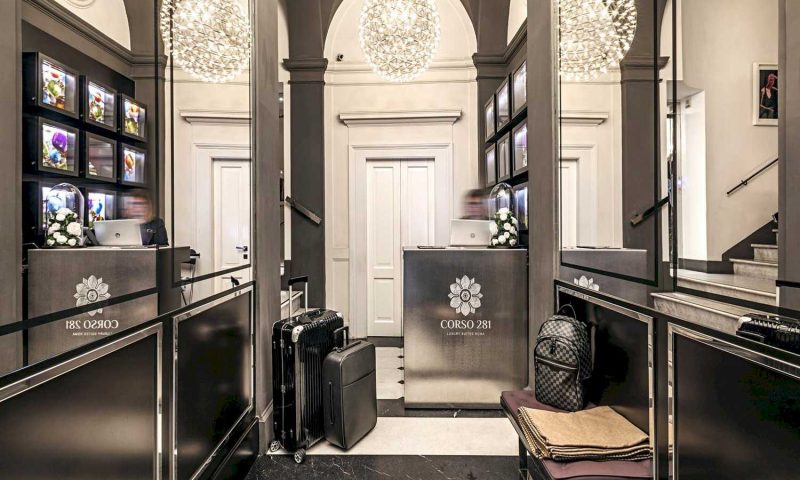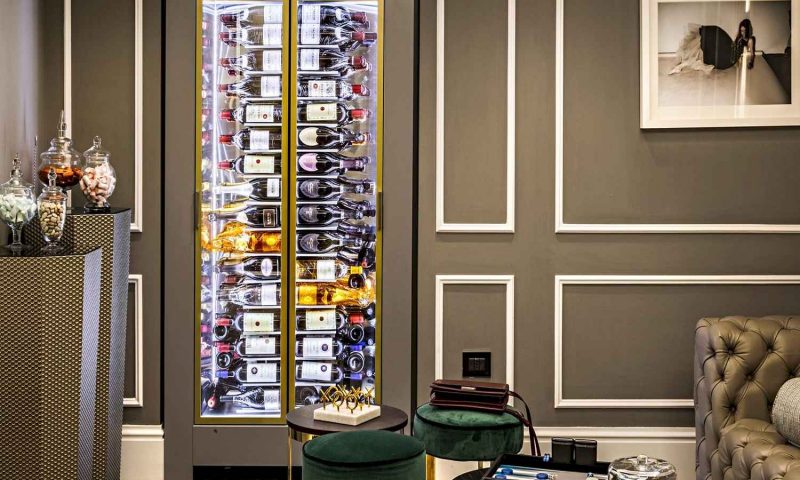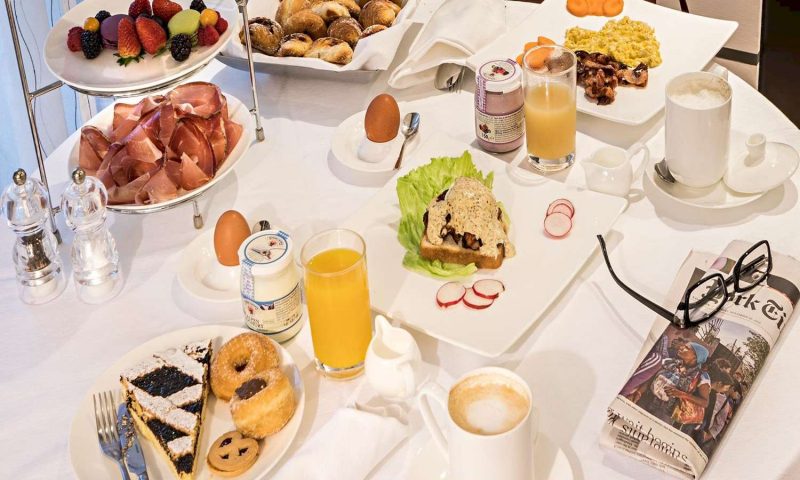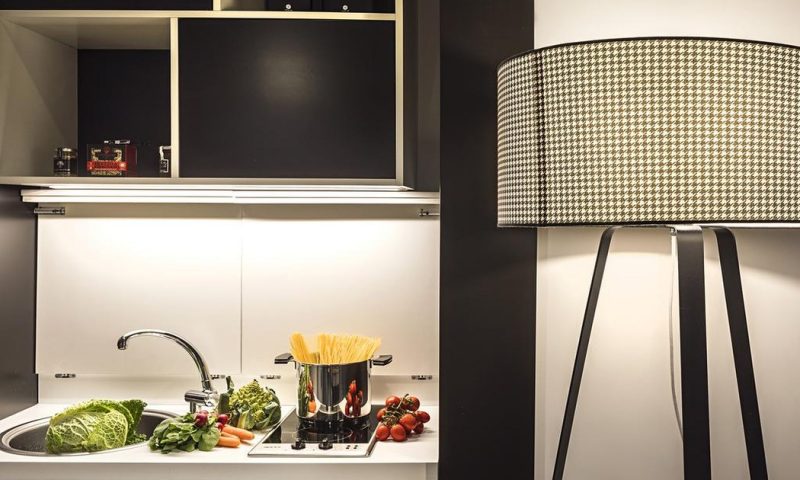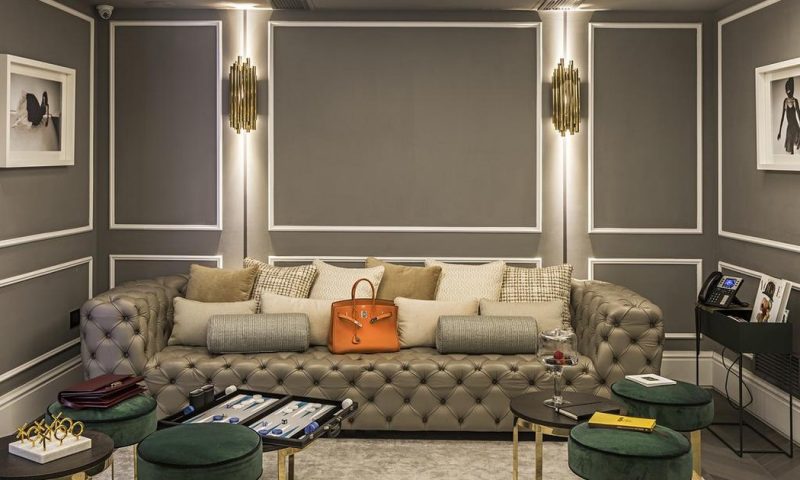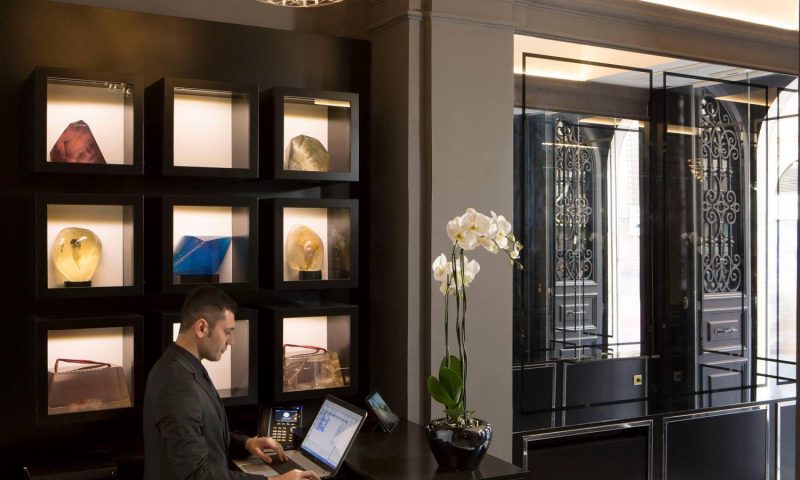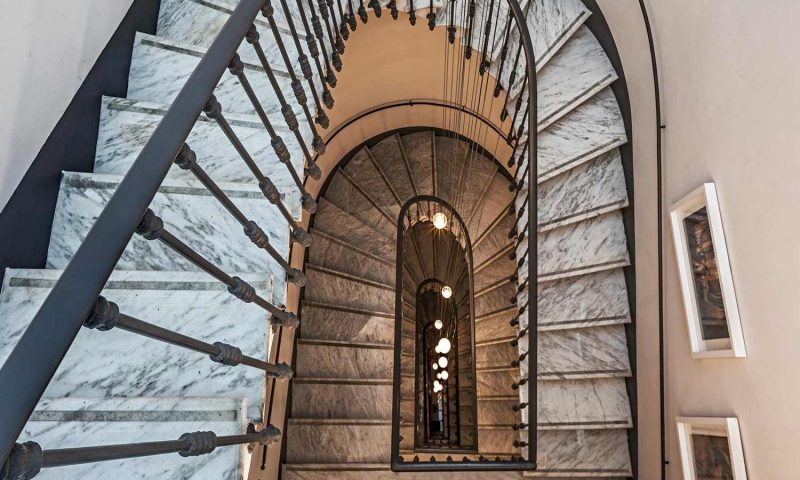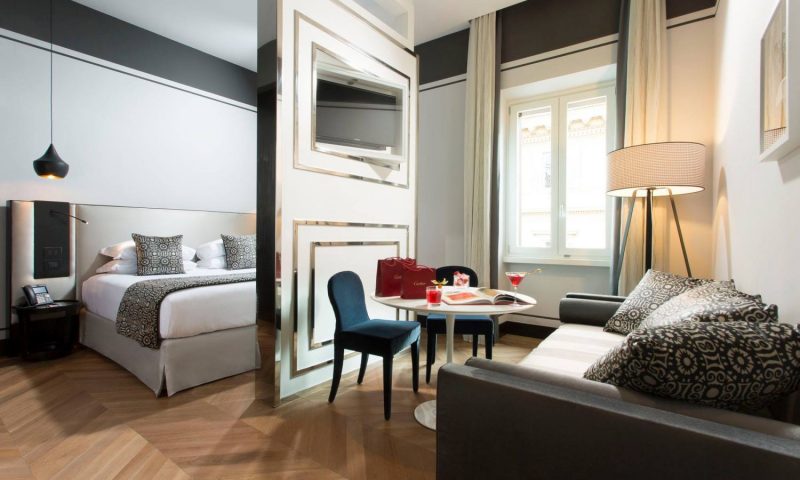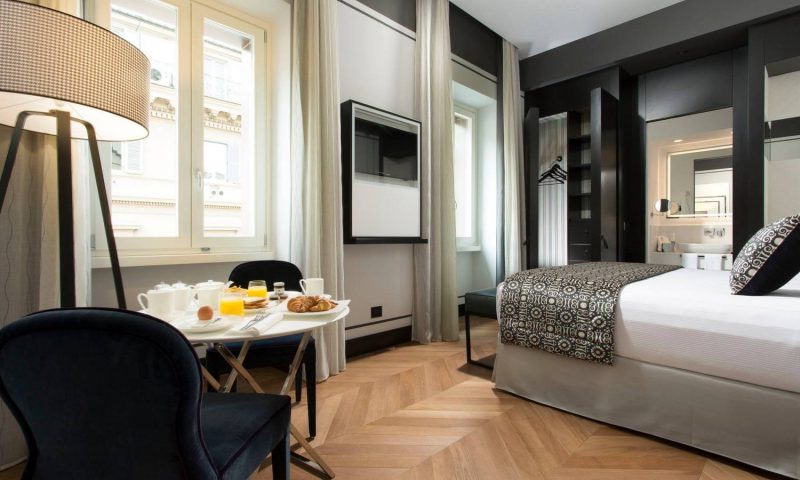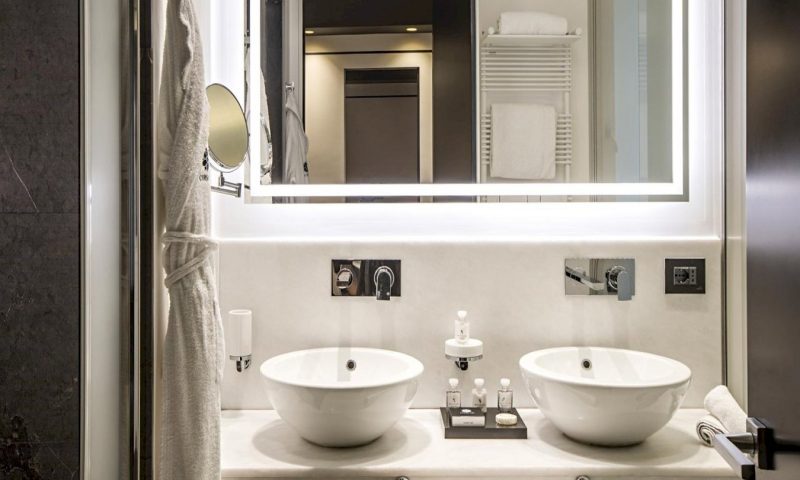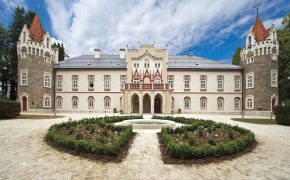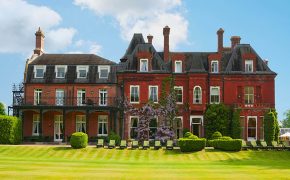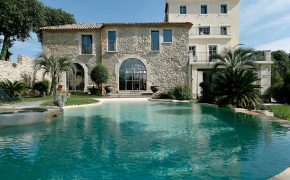“My hotel is the home I was searching for in Rome for a long time. A noble mansion dating back to the late 18th century, Aristocratic for its sophisticated ambience and the uniqueness of its location on the Via del Corso, in the heart of the Eternal City.
Indulging in my love for art and design, I wanted to create an exclusive boutique hotel, a private residence of twelve beautiful suites, each one spacious and peaceful, with a refreshing view over the monument ‘Altare della Patria, Altar of the Fatherland as well as the rooftops of the ancient palaces and residences of the Via del Corso a truly outstanding Avenue.
A myth, the name of this spectacular Avenue which crosses through the historical centre of the city derives from the name of a famous Arabian horse race. That is Rome, a city who lives its past, rewarding a surprise each and every day. This is my hotel, and from today it is also your home.” (Natalino Gisonna)
HOSPITALITY
“I was born into a large family in southern Italy, where only the most sincerest hospitality at all times touched the life of each of us. Warmth and discretion, these are the values which I also extend to my Roman “family” at my hotel, and to you dear guests of Corso 281, you are “my” guests.
For your comfort, both inside and outside the hotel, I have created a new service and called it ‘home assistant’ aimed to fulfill your every desire. I wanted to put at our disposal, my own experience as a “traveller” in the heart of Rome thereby.
I am suggesting my favourite itineraries and museums with the paintings most dear to me, together with my favourite restaurants, cafes and boutiques. It is therefore with simplicity and immense pleasure that I offer to my dearest friends, the best of the Eternal City. (Natalino Gisonna)
SUITES
When I enter a suite I would like to feel the style of the city I am travelling. I would like to contemplate its style, its materials, and perceive its energy. I would like to feel that, that environment can only exist in that part of the world, and nowhere else.
The twelve suites of Corso 281, designed by the Architect Chiara Caberlon, have this quality, an original portrait of contemporary and ancient Rome. Firstly Rome and its ancient grandeur, breathing in the environment in each suite, the bed is monumental the bathroom a tribute to the tradition of a spa, a place to live.
Yet, Rome destination of the Grand Tour, where the trunks magically become the wardrobes and the hatboxes the bedside cabinets…… And then Rome in its baroque season, with the splendor of its shades of black and beige velvet, in contrast with the freshness of its linens. Finally, the Rome of today, from the essential design to the futuristic technology. And here is ‘your suite’, Rome is already yours.
VIA DEL CORSO SUITE
With the finest and most opulent design features and magnificent views that spread out across the city, our Via del Corso Balcony Suite offers a truly unforgettable and contemporary Roman experi-ence.
With almost 400 square feet (35 sqm) of floor space and a luxurious King bed, there is also a day bed with pull out beds if you need. The natural and monochrome tones combine with the up-scale furnishings and fabrics taking decadence to new heights. The elegant marble bathroom de-sign provides for a comforting rain shower, luxury bathrobe and exclusive amenities by Bulgari.
From your in-suite smart device that offers complimentary unlimited local and international calls to the flatscreen TV, Nespresso coffee machine and gourmet stocked mini bar, this designer balcony suite has everything you need for the perfect stay right at your fingertips.
FAMILY SUITE
With every comfort and thought out detail, from two bathrooms to an Italian kitchenette, our spa-cious Family Suite offers the perfect Roman family getaway. Boasting almost 500 square feet (45 sqm) of floor space, they feature a King size bed plus a daybed with twin pull out beds.
The con-temporary look and feel brings together the finest in Italian fabrics and furnishings. The feature here is the two exceptionally appointed and stylish marble bathrooms, one with a shower and one with a bathtub for two and both with luxurious Bulgari amenities.
The living area features a Nespresso cof-fee machine and a plentiful mini bar and all the technology touch-points you need, with the addition of a smartphone with complimentary unlimited local and international calls.
LUXURY SUITE
With the finest features and almost 500 square feet (45 sqm) of floor space, the elegant Luxury Balcony Suite impresses even before you set out to enjoy the balcony’s charming views of the rooftops of Rome. Dressed in the finest linens and fabrics, the sumptuous King bed is comple-mented by a chaise lounge that can be converted into 2 pull out beds.
The sleeping area leads out into the living room which comprises an excellently appointed kitchenette. Delight in the Italian mar-ble appointed bathroom with a double spa bath, plush bathrobes and Bulgari amenities.
The living space is fitted with contemporary furnishings, all the technology and handsets you need, including a smartphone with complimentary unlimited local and international calls. Enjoy a fully stocked mini bar and Nespresso coffee machine too.
DELUXE ROOM
The large and bright Studio Deluxe with over 300 square feet (30 sqm) of floor space brings togeth-er every necessary comfort with the warm modern day feel of a historic Roman palace. The finest linens and furnishings complete the monochrome tones of the suite with a King bed the center-piece.
Here, a pull-out bed is available if required. The fully appointed bathroom is fitted with elegant white and grey Italian marble, luxuriously soft bathrobes and the finest Bulgari toiletries.
The in-room music system, flat screen TV and handheld smart device with complimentary and unlimited local and international calls, keeps you connected at all times. Delight in the simple pleasures from your own Nespresso machine to the fully stocked mini bar all while taking in those views of the famed Via del Corso.
BREAKFAST
All guests have the luxury of enjoying breakfast in the privacy of their own suite or can choose to have it in the comfort of our lounge. I have personally selected the bakery selection and the cold cuts from one of Rome’s finest purveyor, Roscioli so that you can enjoy the best of gourmet Rome first thing.
COOKING CLASS & EN SUITE CHEF
I chose to furnish each of our Executive Suites with kitchenettes so that guests can enjoy a private cooking experience in the very comfort of their pwn Suite, be it for a romantic evening or to celebrate a special occasion.
PRIVATE DINNER
I have devised the Private Dinner Experience so that my guests can be guided through the journey that is Roman cuisine. There are three menus on offer: Traditional Roman, Fusion Roman and Vegan Roman and a private chef at your disposal who will not only cook for you but guide you through the menu and explain all dishes and ingredients. This unique experience brings together the Italian art of dining and cuisine.
HONESTY BAR
In my Caveau, I have personally selected 65 top shelf spirits and liqueurs, with the assistance of one of the best mixologists and bartenders in the world. Together with a collection of drinking utensils and cocktail books, you can mix yourself a cocktail following either the historic or more contemporary recipes.
ROOM SERVICE
At any time of day, my guests can choose from an extensive selection of international and local dishes (hot or cold), with personalized menus, even for children who are more than welcome.
WINES & OILS
I grew up in Calabria and I carry in my heart the love of my region and its wonderful products. That’s why I wanted for my guests to find the magnificent Ferrocinto wines in their suite, one of the oldest and most famous wineries of Castrovillari, a city of Roman origin, its name, Castrum Villarum, the Fortress of the Villas.
The Ferrocinto vineyards date back to 1855 and grow in the Basin of the King, 450 meters high, at the foot of the Massiccio of Pollino, one of the most extraordinary landscapes of Italy.
From this wonderful Producer great red wines are born, such as the “Magliocco,” made from the typical grapes of the Cosenza, lands or the white wines such as “Timpa del Principe”, also the precious sparkling such as the “Dovì”, born from the Chardonnay vineyard, the highest of all the Wineyards.
Ferrocinto also means extra virgin olive oil, an unmistakable flavor. May I suggest the Italian classical cocktail, the most “homemade”, drink? Just a glass of wine, a slice of bread, a little oil, with just a touch of color, a tomato and a basil leaf. You are at home, you’re in the warmth of Southern Italy. And I’m sure, you’re happy.
THE CAVEAU
Here at Corso 281 we appreciate how hectic Rome can get. At one point in the hotel’s long history it served as a bank; in keeping with our commitment to provide you with a home from home, we have replaced the gold of the vault with drinks and a place to call your own.
I want you to feel at ease and the wide choice of liquors, wines and champagne I have personally selected, will give you the feeling you are raiding my home’s drinks cabinet! All we ask is you let us know what you’ve had.
So, whatever time of day you feel the need to escape to your own “vault”, you will find this one fully stocked and waiting for you. There are plenty of vaults with only gold inside, this one holds a treasure for more important: your holiday.
SERVICES
I thought up each suite as a private house which opens onto Rome’s charm. You are the protagonists and we carry out your wishes. From the moment you arrive at the hotel you will be looked after by your home assistant who will show you around and demonstrate each service, and will be at your disposal along with his or her colleagues at the Reception, 24/7.
Do you want to sample the uniqueness of the Roman cuisine at one of its traditional addresses or do prefer to test the latest trendy restaurant? Do you prefer a stroll alongside a famous Archaeologist or an Art historian, or perhaps a ride along the Via Appiaon a Vespa?
Would you enjoy a day of high fashion shopping? What about a peek at the city’s most famous antique shops? A ride in a helicopter or do you wish to charter a private yacht for the day going to the beach in the Island of Capri or Ponza? I will simply open my diary and you will start your vacation.
MASSAGE
To unwind after your journey and to fully enjoy the beauty of Rome, I suggest you take advantage of the in-suites massage service. Some of Rome’s most talented professionals are at your disposal for a Jet-Leg, Relaxation, Deep Muscle or Shiatsu massage.
BUSINESS
The Hotel provides a Lounge room equipped with a table, retractable LCD monitor and everything you need for a small business meeting. It is also available for a coffee break and lunch or dinner with a private chef.
LIBRARY & VUNILS
In a space adorned by the arch vault that date back to 1750, you can read your own favorite book or a Rome guide, as vinyl tunes play on our vintage record player.
CONCIERGE
I want my guests to always feel at home at any time of the day or night. For this, I offer concierge service with multilingual staff on hand and available 24 hours a day. Guaranteed to ensure only the best service both in their room as well as outside the hotel. Your home assistant is ready to fulfill every request. He or she will guarantee your every need is met and just as if I was tight there too, standing next to them.
At the time of booking I invite you to choose your preferred type of pillow, feather, natural or synthetic fiber, and your mattress, soft or extra soft. Also, to ensure your stay is even more personal and pleasant it will be a pleasure to stock the mini bar with your own favorite choice of brands of champagne and spirits.
Our reception will look after you also throughout your Roman days by happily suggesting my own favorite places to visit or to offer you the service of only the best guides to discover the city.
DISCOVER ROME
Rome is wonderful and immense. It alway was and still is Caput Mundi. What can I advise my guests so that they feel already here, in the center of the Eternal City? A simple and extraordinary journey to Via del Corso the address of their suite.
It ‘s my favorite walk from ,Piazza Venezia to Piazza del Popolo, from the Altar of the Fatherland to the masterpieces of Caravaggio. 1,500 meters long, every day I see more than 2000 years of history, and they are beautiful buildings, museums, churches, and of course the Avenue itself, during the time of the Emperor Augustus it was called the “Via Lata.”
In 1466 Pope Paul II decided to celebrate the feast of Carnival, and in particular the Arabian horse race here, all along this Avenue, the ùavenue took its name from this and has retained it ever since, even after the abolition of the horse racing in 1883.
May I introduce you to your “neighbours”? Meaningfully, the fifth monumental of Piazza Venezia, the Altar of the Fatherland, from its terrace you can enjoy a spectacular view over the whole city. To the left side of the hotel, Palazzo Bonaparte, the home of Napoleon Bonaparte’s mother.
Shall we continue? In front and to the right of the Hotel you can admire the masterpieces of the Galleria Doria Pamphili, with one of the most valuable art collections in Rome.
Only a few more steps further and you are right in front of the magnificent Piazza Colonna – the name of the Column of Marcus Aurelius, built back in 192 AD. Then on to the Palazzo Chigi, seat of the Italian government. Turn left and in no more than a moment you will arrive at the Pantheon.
If you want to continue with me, we then reach the intersection with Via Condotti stop for a little ‘shopping’ or stop for a Coffee at the Caffè Greco – the Greek coffee shop? Then what? Then, we continue on to arrive in front of the breathtaking Piazza del Popolo.
To your left Caffè Rosati. This is world famous and for those who saw and love the film “Roman Holiday” you will remember Audrey Hepburn and Gregory Peck sitting at these very tables.
Diagonally across on the opposite side, rises the Church of Santa Maria del Popolo, two of the most amazing works of Caravaggio are found right here. Now? Well, I must go back to the hotel, but you can continue to enjoy all the beautiful spectacles Rome has to offer.
THE COLOSSEUM
The original name for the Colosseo is the Anfiteatrum Flavium. It was built by emperor Vespasiano and inaugurated in 80 A.D. In ancient times it was the site of the “Naumachie” or navy-battles, the “Munera” or gladiator-fights,and the “Venationes” or wild animal-hunts.It could hold up to 87.000 people.
DOMUS AUREA
The construction of the Domus Aurea (the Golden House) was considered as one of the most crazy enterprises of the city. When two thirds of Rome were burnt down by the big fire in 64 AD, emperor Nero (54-68 AD) used the free space for a new accommodation.
The architects have done all possible things to satisfy his megalomania. The accommodation had to cover four districts. The palace itself radiated a tremendous luxury. The most important part was a large rectangle at the Oppius hill where the four corner parts covered the four districts.
The rooms, halls and corridors were abundantly decorated with gold, silver and precious stones. The eastern wing of the accommodation was used for public receptions. The western wing was the house of Nero. It was said that it had a round dining-room, which turned around day and night, inspired by the revolutions of the earth.
PANTHEON
Placed in “Piazza della Rotonda” near “Piazza Minerva” it was named “Pantheon” because it was a temple dedicated to several divinities. Thanks, first, to the restoration by Domiziano, and then to the reconstruction by Adriano in 130 A.D., it has remained nearly integral.
In 609 A.D. this temple was given by Emperor Foca to Pope Bonifacio IV and changed into a church; this is the reason why it is still in excellent conditions. Nearly all what you can admire was built in Roman age, even the dome, 43,4 metres high, and the solid bronze door.
The arcade is decorated, inside, with valuable polychrome marbles whereas its façade has 16 monolithic granitic columns which are 14 metres high. Inside, the “Pantheon” has a circular plan and a stately lacunar dome.
The only opening is in the middle of the dome and creates a luminous effect that exalts the grandiosity and the harmony of this monument. In its chapels there are numerous works of art and the tombs of thrItalian royal families, of Baldassarre Peruzzi and Taddeo Zuccari and, above all, there is Raffaello’s grave.
CASA DI AUGUSTO
The bas-reliefs, bronzes, coins, sculptures and paintings on display aim to get the concept of ‘Roman victories’ across to the public by telling us about the ceremonies and festivities surrounding the historic big battles.
The first section of the exhibition relates to victories and their development, from the Etruscan to the Hellenistic worlds; the second section shows images of illustrious victors and the illustrious defeated – among which Caesar, Pompeius and Octavian – and reproduces battle scenes.
Recently inaugurated after 20 years of restoring works, the home where Ottaviano lived before beginning Emperor is now finally re-opened to public visiting. Some decorations of walls are still the original ones, beside others have been re-created like original colors as red, blue and yellow typical of the Imperial Time. Visit can be allowed to group of maximum 5 persons in order to avoid possible damage to decorations.
VATICAN CITY
Every day, around 30.000 people visit the Saint Peter’s Basilica. It’s the most important and largest catholic church in the world, the one where the pope celebrates, and has a unique artistic, religious and historical importance.
Requested by Giulio II, the building of the church started on the 18th of April 1506 and ended in 1667, in the same place where an ancent church used to be, and where traditionally Saint Peter, founded of the Catholic Church, had been buried.
Inside Saint Peter’s in Rome you can visit the “Sacred grottos”, where all Popes are buried, the Historical and artistic museum and the very popular Saint Peter’s cupola, which you can reach also by lift.
The Saint Peter’s Grave and the Necropoli (ancient cemetery) are underneath Sain’t Peter’s Basilica and it’s necessary to send a request in advance to the Fabbrica di San Pietro in order to see it.
VATICAN’S GARDENS
The Vatican’s Gardens were created as a rest and meditation place for the Pope, and have elements of great artistic and institutional importance for the Vatican State. In order to visit the Gardens, it’s necessary to book.
THE VATICAN’S LIBRARY
Only Phd researchers can access the Vatican’s Library, which hosts some of the world’s most important antique books and rarities collections.
MUSIC & OPERA
The theatre, opera and ballet season in Rome offers always very interesting shows. We will list here only a few among the most important roman thatres which are close to our hotel: il Salone Margherita, in via Due Macelli 75, with vurtain raisers and variety shows; the teatro Eliseo, with classic theatre and contemporary shows; as well as Sistina, with music and tv shows.
Opera and ballets take place at the Teatro dell’Opera di Roma in Piazza Beniamino Gigli, 7 with international opera, ballet and contemporary dance shows. Not far from Corso 281 Hotel is also the Auditorium Parco della Musica, that thanks to its big theatres designed by Renzo Piano offers many different kind of theatre, music and dance shows.
SAINT GIOVANNI IN LATERANO
The cathedral of Rome was founded by Pope Melchiades (3rd c.), but on the occasion of the 1650 Jubilee Borromini decorated the old structures with stucco work and polychrome marbles. The last door on the right of the monumental façade is opened only in Holy Years.
Among the funeral monuments and cardinals’ tomb inside, worthy of note is the recumbent statue of Riccardo Annibaldi by Arnolfo di Cambio (1276). Of great interest is the suggestive cloister (13th c.) with its elegan columns dorned with mosaics.
SAINT PAUL BASILICA
Erected in the year 324 over the tomb of St. Paul, the basilica was almost entirely rebuilt after the fire of 1823. It holds a number of noteworthy works of art: the famous tabernacle by Arnolfo di Cambio (1285); the paschal candlestick by the Vasselletti (12th c.) and, in the apse, the mosaic depicting “Christ blessing, Honorius III and saints”. There is an interesting cloister with splendid polychrome marble inlays and mosaics.
SANTA MARIA MAGGIORE
Rebuilt by Sixtus III in the 4th c., it was modified in the 12th c. and its exterior was transformed during the Baroque period. The interior maintains the simple, linear appearance of the primitive paleochristian basilica and is decorated with a cycle of splendid mosaics: Stories from the Old Testament; (5th c.) in the nave, scenes from the “Early life of Christ” on the triumphal arch, and the apse mosaic of the “Coronation of the Virgin” by Jacopo Torriti (1295). Of great importance are the Cappella Paolina, the altar of precious stones, and the crèche by Arnolfo di Cambio.
VILLA BORGHESE
This is the most famous villa both for its dimension and tha various ways of access to the city. Cardinal Scipione Borghese wanted it to be built at the beginning ohìf the 17th century between the Flaminio area and the Parioli area where the Lucullo gardens stood. The main building, inspired by 16th century style, was covered on the outside by old sculptures whereas the sober interior hosted great works of art.
At the beginning of the 19th century Prince Camillo Borghese set up the art collection of the family in the casino which today is where the gallery and the Borghese museum stand. It was extended towards the Muro Torto and thus the villa was refurbished to also include an English garden landscape.
There are many beautiful items worthwhile noticing: the Italians gardens near the Casino Borghese, the Casino alla Meridiana and around tha aviary; avenues and paths embellished by statues and fountains; the Garden of the Lake, thus called because it stretches around an artificial lake; there is a small temple dedicated to Aesculapius on a islet in the middle of the lake and a 17th century copy of the arch of Septimius Severus.
VILLA MEDICI
The villa, which hosts the French Academy at Trinità dei Monti, was started in the second half of the 16th century, it was bought in 1576 by Cardinal Ferdinando de’ Medici. The gardens which stretch along the avenues bordered by high hedges are embellished by statues sarcophagi and fountains.
There were splendid waterworks during feasts when it was the Embassy of Florence in the 18th century. The villa became property of the ruling house of Florence when the Medici family became extinct. It was thropugh them that Napoleon Bonaparte made it the headquarter of the French Academy. The building was open to the public in 1928 and since then has hosted art exhibitions.
VILLA DORIA PAMPHILI
The villa became the largest public park in the city in 1971. It has become a favourite place for jogging and dog owners. The oldest part at 183 of the Aurelia Antica is Villa Vecchia, which already existed when Panfilo Pamphili bought in 1630.
The new villa was built between 1644and 1652 by Algardi and Grimaldi when Innocent X Pamphili was Pope. The richly frescoed halls of the villa having access from 111 Via Aurelia were embellished by a collection of statues, which today are in the Capitolini Museums.
Changes, extension and new constructions to the villa continued in the 19th century. The villa joined to Villa Corsini and the entrance of Via Porta San Pancrazio became the main entrance following the war events of the Roman Republic of 1849.
VILLA D’ESTE
Villa d’Este, masterpiece of the Italian Garden, is included in the UNESCO world heritage list. With its impressive concentration of fountains, nymphs, grottoes, plays of water, and music, it constitutes a much-copied model for European gardens in the mannerist and baroque styles.
The garden is generally considered within the larger – and altogether extraordinary – context of Tivoli itself: its landscape, art and history which includes the important ruins of ancient villas such as the Villa Adriana, as well as a zone rich in caves and waterfalls displaying the unending battle between water and stone.
The imposing constructions and the series of terraces above terraces bring to mind the hanging gardens of Babylon, one of the wonders of the ancient world. The addition of water including an aqueduct tunneling beneath the city evokes the engineering skill of the Romans themselves.
VILLA ADRIANA
Hadrian’s Villa near Tivoli (Rome) was built by Emperor Hadrian, starting from 117 A.D., as an imperial palace far away from the city of Rome. It is the most extensive ancient roman villa, covering an area of at least 80 hectares, more or less as Pompeii.
In 1999 Villa Hadriana was appointed one of the Human Heritage Monuments by Unesco; as many other archaeological sites it is very famous, but still very little known in its essence, notwithstanding more than 500 years of excavations. A more scientific and modern approach to its study is a recent novelty.
Villa Hadriana lived until late antiquity, was sacked by the Barbarians of Totila, and during the Middle Ages became a quarry of building materials for the city of Tivoli and its bishop; her identity was lost, being with new name Tivoli Vecchio (Old Tivoli).
At the end of the XV century, Biondo Flavio identified again the site as the Villa of the Emperor Hadrian described by the Historia Augusta; at the same time, Pope Alexander VI Borgia promoted the first excavations in the Odeon theater, discovering several statues of seated Musae, now in the Prado Museum of Madrid, Spain.
Later on, Pope Pius II Piccolomini visited the Villa and described it in his Commentarii, making the site very famous from then on.
VATICAN MUSEUMS
The Vatican Museums originated as a group of sculptures collected by Pope Julius II (1503-1513) and placed in what today is the “Cortile Ottagono” within the museum complex. The popes were among the first sovereigns who opened the art collections of their palaces to the public thus promoting knowledge of art history and culture.
As seen today, the Vatican Museums are a complex of different pontifical museums and galleries that began under the patronage of the popes Clement XIV (1769-1774) and Pius VI (1775-1799). In fact, the Pio-Clementine Museum was named after these two popes, who set up this first major curatorial section.
Later, Pius VII (1800-1823) considerably expanded the collections of Classical Antiquities, to which he added the Chiaromonti Museum and the “Braccio Nuovo” gallery. He also enriched the Epigraphic Collection, which was conserved in the Lapidary Gallery.
Gregory XVI (1831-1846) founded the Etruscan Museum (1837) with archaeological finds discovered during excavations carried out from 1828 onwards in southern Etruria.
Later, he established the Egyptian Museum (1839), which houses ancient artifacts from explorations in Egypt, together with other pieces already conserved in the Vatican and in the Museo Capitolino, and the Lateran Profane Museum (1844), with statues, bas-relief sculptures and mosaics of the Roman era, which could not be adequately placed in the Vatican Palace.
The Lateran Profane Museum was expanded in 1854 under Pius IX (1846-1878) with the addition of the Pio Christian Museum. This museum is comprised of ancient sculptures (especially sarcophagi) and inscriptions with ancient Christian content.
In 1910, under the pontificate of Saint Pius X (1903-1914), the Hebrew Lapidary was established. This section of the museum contains 137 inscriptions from ancient Hebrew cemeteries in Rome mostly from via Portuense and donated by the Marquisate Pellegrini-Quarantotti.
These last collections (Gregorian Profane Museum, Pio Christian Museum and the Hebrew Lapidary) were transferred, under the pontificate of Pope John XXIII (1958-1963), from the Lateran Palace to their present building within the Vatican and inaugurated in 1970.
BORGHESE GALLERY
The original sculptures and paintings in the Borghese Gallery date back to Cardinal Scipione’s collection, the son of Ortensia Borghese – Paolo V’s sister – and of Francesco Caffarelli, though subsequent events over the next three centuries entailing both losses and acquisition have left their mark.
Cardinal Scipion was drawn to any works of ancient, Renaissance and contemporary art which might re-evoke a new golden age. He was not particularly interested in medieval art, but passionately sought to acquire antique sculpture. But Cardinal Scipione was so ambitious that he promoted the creation of new sculptures and especially marble groups to rival antique works.
The statue of Pauline Bonaparte, executed by Canova between 1805 and 1808, has been in the villa since 1838. In 1807, Camillo Borghese sold Napoleon 154 statues, 160 busts, 170 bas-reliefs, 30 columns and various vases, which constitue the “Borghese Collection” in the Louvre.
But already by the 1830s these gaps seem to have been filled by new finds from recent excavations and works recuperated from the cellars and various other Borghese residences. Cardinal Scipione’s collection of paintings was remarkable and was poetically described as early as 1613 by Scipione Francucci.
In 1607, the Pope gave the Cardinal 107 paintings which had been confiscated from the painter Giuseppe Cesari, called the Cavalier d’Arpino.
In the following year, Raphael’s Deposition was secretely removed from the Baglioni Chapel in the church of S.Francesco in Perugia and transported to Rome. It was given to the Cardinal Scipione through a papal motu proprio.
THE VITTORIANO
It was built, using white limestone, in 1885 and was inaugurated in 1911 but it took almost twenty years to be completed. Besides, being the symbol of Italian unity since 1921, it also considered the altar of the Italian land. Two sentries of honor continuously watch the tomb the Unknown Soldier which keeps the remains of an unknown soldier died during the World War.
An enormous flight of steps, flanked with winged lions and two bronze ‘Vittorie’, leads to the altar of the Italian land. It shows high-reliefs by Angelo Zanelli, in the middle of which, you can admire the Rome statue.
In the middle of this monument there is the gigantic equestrian statue of king Victor Emmanuel II, realized in bronze by Enrico Chiaradia. Behind, the monument shows a grandiose porch with columns 15 metres high and two colossal bronze quadrigae with winged ‘Vittorie’, realized by Carlo Fontana e Paolo Bartolini.
PALAZZO ALTEMPS
The Palazzo was commissioned by Girolamo Riario (1443-1488). In 1568 it passed into the hands of the Altemps family, which had it enlarged and built the courtyard. This feature of the building, without a doubt its most handsome, is credited to Martino Longhi the elder. Restoration work has been under way since 1984, and steps are being taken to arrange the exhibit.
Apart from the Ludovisi Throne, which is kept in the Palazzo Massimo, the collection boasts works of great artistic value, such as the Gaul who kills himself together with his wife, a copy of an originalfrom Pergamon; the Ludovisi Ares, a copy traceable to Lysippus; the Castelporziano mosaic (IInd cent.), one of the most important known Roman mosaics; the Ludovisi Hermes, copy of a bronze original by the school of Myron; the Aphrodite of Cnidus, a copy of the reknowned Aphrodite by Praxiteles, and a colossal sarcophagus depicting a battle between Romans and Barbarians.
VILLA DELLA FARNESINA
It is placed in front of Corsini Palace, in “via della Lungara”. It was constructed from 1506 up to 1510 according to Agostino Chigi’s will, who was a Sienese banker. After the banker’s death, this villa underwent a period of decay, during which, many works of art, kept here, were taken away.
In 1577 this villa was acquired by cardinal Alessandro Farnese. Since then it was named “Villa Farnesina”. It is characterized by a central block with a loggia consisting of five arcades and by two lateral outposts.
The simple design of the building matches very well the surrounding garden. Moving from the nineteenth-century atrium, you can reach directly the “Loggia di Psiche”, admirably frescoed in 1517 by Raffaello’s pupils.
From the loggia you can approach directly the room of Galatea, the ceiling of which was decorated by Peruzzi in 1511. The most important fresco in this room is the famous Raffaello’s “Galatea”.
At its top storey there is the splendid great room of the “Prospettive”, frescoed by Peruzzi and his pupils in 1518. You can also admire the Cabinet of the Print, a collection of rare prints, founded in 1895 in order to keep Corsini’s prints and designs.
TREVI FOUNTAIN
In Italian “Tre vie” means three roads, so the name of the fountain comes from the three roads that come together at the busy Piazza di Trevi. The fountain has recently been restored to its former grandeur.
The Trevi Fountain celebrated the reopening of several of ancient Rome’s aqueducts in the Renaissance and Baroque eras. The central figures are Neptune flanked by two Tritons. One struggles to master a very unruly sea horse, the other leads a far more docile animal.
These symbolize the two contrasting moods of the sea. One of the most celebrated scenes in Italian cinematic history must be the moonlight dip taken by the enchanting Anita Ekberg in Federico Fellini’s 1960 film “La Dolce Vita”.
Romantics toss a coin over their shoulder, thinking it will grant them a wish and assure their return to Rome. Every week thousands of euros are collected from the fountain and given to the charity Caritas who use it to buy food and clothes for people in need.
SPANISH STEPS
This square owes its name to the fact that Spain chose it as the location for its embassy to the Holy See. Travelers come here in search of knowledge and artistic inspiration. The fontana della Barcaccia is a masterpiece by Bernini. He constructed a fountain ine the square which represents a leaking boat in a shallow pool; barcaccia means a useless, old boat that lies half submerged.
The wide, curving staircase is one of Rome’s iconic sights. The Spanish steps consists of 138 steps leading sharply up from Piazza di Spagna, forming a butterfly shape as they fan out around a central terrace. The design culminated at the top in an obelisk framed by two baroque church towers. The areas surrounding Piazza di Spagna, at the base of the Spanish steps, are the most famous shopping districts for the big global brands.
PALAZZO VALENTINI
This historic palace, a few metres from Piazza Venezia, the Forum and the Baths of Trajan, has been the seat of Rome’s provincial administration. A Major excavation project revealed a group of senatorial villas buried beneath it. It’s one of the finest archeological sites to come to light in recent years; an astonishing sight, with a beautiful mosaic floor, the remains of walls and frescoes.
The multimedia museum inside the building has recreated the past with virtual reconstruction, videos and graphics. Visitors can see rooms, peristyles, baths, kitchens, walls, furnishings and decoration brought back to life, taking a virtual tour of a great Domus of ancient Rome.
